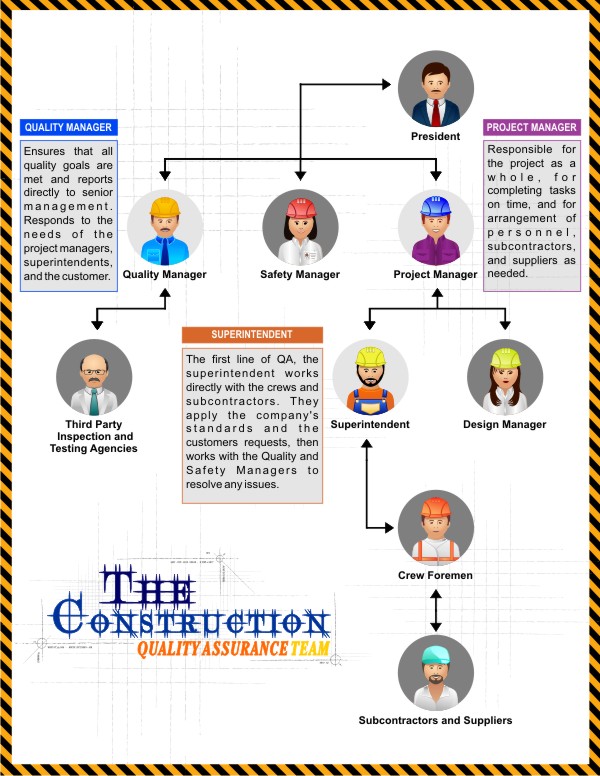The first step in ensuring quality construction after a new contract has been awarded is to set up your quality control team (or quality assurance team, which ever you'd prefer). This consists of management personnel reporting to the head office (via the president or a vice president, depending on your company organization).
Your QA team involves more than QA staff. It also includes the Project Manager, who handles organizing the construction project itself, and the Quality Manager, who is directly responsible for quality assurance efforts. The third (and crucial) member of the team is the Superintendent. The Superintendent is the quality team’s connection with crew foremen, construction teams, and subcontractors.
Below is a typical organizational structure for a construction project team..jpg)
The responsibilities of each member of the team are described as follows.
Quality Manager
It’s important that the quality manager reports directly to the company’s senior management. This preserves the independence of the manager from the pressures of production. The manager’s only responsibility is the quality of the work. In this way, there will be no temptation to cut corners or compromise quality.
The Quality Manager is the person directly responsible for ensuring that quality goals are met. He reports directly to senior management and is also responsive to the needs of project managers, superintendents, and the customer. His choices and actions directly impact the project’s ability to achieve its goals in regard to timeliness, safety, and quality, and the company’s goals of always improving quality of work.
It is the Quality Manager’s responsibility to develop a set of project standards that comply with customer specifications and requirements, regulations, industry standards, product instructions, and the company’s standards and requirements. The Quality Manager is also responsible for evaluating and training personnel and ensuring that all materials used in the project meet the standards required.
Regardless of any other responsibilities, the Quality Manager has the duty to:
- Plan project quality controls
- Implement and manage all phases of quality control
- Communicate project-specific quality requirements to all affected departments, subcontractors and suppliers, and customers
- Ensure that everyone follows the quality plan
- Monitor progress of activities
- Act as the liaison with parties outside the company on matters relating to quality
- Report to senior management on quality-related performance, including needed improvements
- Review and approve all project quality system records
- Review and approve project quality-related contract submittals
- Manage all project inspection and quality control activities
- Manage corrective actions
- Resolve quality nonconformances
The Quality Manager has the authority to:
- Stop work when continuing work may adversely affect quality or cover up a defect
- Prevent the use of equipment or materials that may adversely affect quality or cover up a defect
- Direct the removal and replacement of any non-conforming work, equipment, or material by the company, any subcontractor, or any supplier.
- Suspend work and/or supply of materials by any staff member, subcontractor personnel, or supplier as deemed necessary to assure quality.
An alternate quality manager can be appointed to take on responsibilities for a limited time. Moreover, on small projects, it may be appropriate for the project manager to have some quality manager responsibilities.
Project Manager
The Project Manager, as the title implies, is the overall manager for the construction project. The Project Manager is responsible for the project as a whole, for completing tasks on time, and for arrangement of personnel, subcontractors, and suppliers as needed. Quality assurance is only one of the Project Manager’s concerns, but it should be a very high priority.
Regardless of other duties, the Project Manager is responsible for:
- Demonstrating commitment to quality
- Providing adequate resources for quality assurance on the project
- Conducting management reviews of the company’s quality system itself.
Superintendent
The Superintendent or Superintendents apply the company’s standards and the customer’s requirements hands-on to the project on a day to day basis. The Superintendent is the first line of quality assurance, the person who deals directly with work crews and subcontractors, and who is usually the first to spot a problem. Superintendents work closely with the Quality Manager and Safety Manager to make certain that any issues are known to management as soon as possible.
A Superintendent has the specific responsibility to:
- Ensure that work meets the requirements of government regulations and codes, customer expectations, contract requirements and technical specifications, and company quality standards
- Ensure that subcontractors and suppliers begin work in accordance with the company’s start-work policies
- Ensure that subcontractors and suppliers receive a notice to work only when conditions will not adversely affect quality results
- Conduct quality inspections and tests, and record findings
- Accurately assess subcontractor quality and on-time performance
- Ensure that quality standards are achieved before approving subcontractor or work crew completion of work
The Superintendent has the authority to:
- Stop work when continuing work may adversely affect quality or cover up a defect
- Prevent the use of equipment or materials that may adversely affect quality
- Direct the removal or replacement of any non-conforming work, equipment, or material
- Suspend work and/or supply of materials as deemed necessary to assure quality
While these are the people primarily responsible for development and implementation of the quality plan, quality is a company-wide goal and each employee is responsible for it within his own work area.
All employees have quality responsibilities that include:
- Ensuring that his own work complies with the project quality plan
- Meeting or exceeding all applicable regulations, codes, industry standards, and manufacturer specifications as well as meeting or exceeding our customers’ contract and individual requirements.
All employees have the authority to:
- Stop work when continuing work may adversely affect quality or cover up a defect
- Prevent the use of equipment or materials that may adversely affect quality.
Conclusion
Before you begin a project, you need to choose the quality assurance team and have them clearly understand their responsibilities for quality assurance. It’s always crucial to know where the buck stops, and people are more important than policies just as judgment is more important than hard-and-fast rules. The three-fold structure of the quality team (Project Manager, Quality Manager, and Superintendent) forms a bridge from the company’s top management to the hands-on, get-it-done person in the field. The cornerstone of the quality team is the Quality Manager, who has the primary responsibility for quality assurance on the project. The Project Manager integrates quality concerns into the overall goals of the project, while the Superintendent translates quality concerns into day-to-day management of work teams and subcontractors.
With the quality team in place, you’re ready to move on to the next step: designing the Quality Plan for the project.






